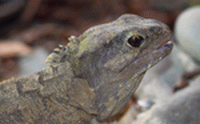What can a New Zealand reptile tell us about false teeth?

Using a moving 3D computer model based on the skull and teeth of a New Zealand reptile called tuatara, a BBSRC-funded team from the University of Hull, University College London and the Hull York Medical School has revealed how damage to dental implants and jaw joints may be prevented by sophisticated interplay between our jaws, muscles and brain. This research will appear in a future edition of the Journal of Biomechanics.
The tuatara is a lizard-like reptile that has iconic status in its homeland of New Zealand because its ancestors were widespread at the time of the dinosaurs. Unlike mammals and crocodiles which have teeth held in sockets by a flexible ligament, tuatara have teeth that are fused to their jaw bone - they have no ligament, much like modern dental implants."
BBSRC postdoctoral fellow Dr Neil Curtis from the University of Hull said "Humans and many other animals prevent damage to their teeth and jaws when eating because the ligament that holds each tooth in place also feeds back to the brain to warn against biting too hard."
Dr Marc Jones from University College London, also a BBSRC postdoctoral fellow, added "In the sugar-rich western world many people end up losing their teeth and have to live with dentures or dental implants instead. They've also lost the periodontal ligament that would attach their teeth so we wanted to know how their brains can tell what's going on when they are eating."
The team has created a 3-D computer model of the skull of the tuatara to investigate the feedback that occurs between the jaw joints and muscles in a creature that lacks periodontal ligaments.
"Tuatara live happily for over 60 years in the wild without replacing their teeth because they have the ability to unconsciously measure the forces in their jaw joint and adjust the strength of the jaw muscle contractions accordingly", said Dr Curtis.
Although this explains why tuatara and people with false teeth manage not to break their teeth and don't end up with jaw joint disorders, it is still clear that having a periodontal ligament is very useful, in particular for fine tuning chewing movements. This may explain why it has evolved independently in the ancestors of mammals, crocodiles, dinosaurs, and even some fish.
There is anecdotal evidence to suggest that people with implants and dentures may make food choices related to their lack of periodontal ligament. However, the tuatara pursues a broad diet on the islands where they live including beetles, spiders, snails, frogs and occasionally young seabirds.
Professor Douglas Kell, BBSRC Chief Executive said "To support the extension of health and wellbeing into old age, it is vital that we appreciate how we as human beings have developed our extraordinary ability to adapt to adverse situations. This work allows us to understand some of the complexities of the feedback and responses occurring in healthy human bodies and brains. It is impossible in evolution to predict future innovations such as dental implants and yet this research indicates a level of redundancy in our biology that opens opportunities to support long term health and wellbeing."
More information: Journal of Biomechanics: "Feedback control from the jaw joints during biting: An investigation of the reptile Sphenodon using multibody modelling", N. Curtis, M.E.H. Jones, S.E. Evans, P. O'Higgins, M.J. Fagan, Journal of Biomechanics, DOI:10.1016/j.jbiomech.2010.08.001
















